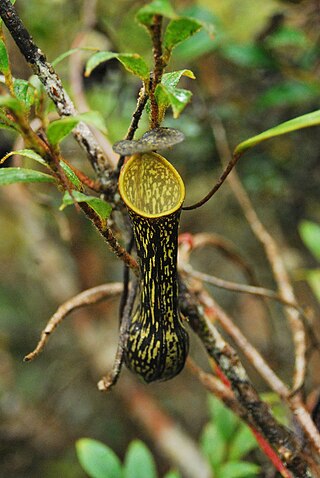
Nepenthes mikei is a tropical pitcher plant endemic to Sumatra. It is characterised by its black mottled lower and upper pitchers. The species is closely related to N. angasanensis and N. tobaica.

Libertia is a genus of monocotyledonous plants in the family Iridaceae, first described as a genus in 1824. It is native to South America, Australia, New Guinea, and New Zealand. Eight species are endemic to New Zealand.

Libertia grandiflora, the tukauki or mikoikoi, is a flowering plant in the family Iridaceae. The species is endemic to New Zealand, and is found on the North Island and the northern part of the South Island. It is a clump-forming herbaceous perennial growing to 90 cm (35 in) tall by 60 cm (24 in) broad, with leathery linear leaves and panicles of white flowers in spring, followed by seed capsules. The Latin grandiflora means large flowered; its flowerheads can grow up to three centimetres across.

Lucy May Cranwell was a New Zealand botanist responsible for groundbreaking work in palynology. Cranwell was appointed curator of botany at Auckland Museum in 1929, when she was 21 years old. As well as her work on ancient pollen samples she was responsible for encouraging a love of botany in a generation of Auckland children.
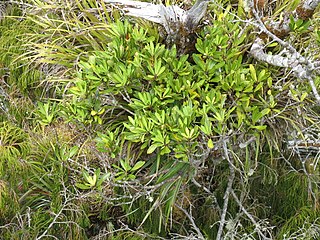
Pittosporum kirkii is a glabrous evergreen perennial shrub that reaches up to 5 metres (16 ft) in height and possesses distinctive coriaceous, fleshy, thick leaves. It is one of four shrubs endemic to New Zealand that frequently displays an epiphytic lifestyle. P. kirkii is commonly epiphytic, perched amongst nest epiphytes in the canopies of emergent or canopy trees in old-growth forest; however, it can be observed occasionally growing on the ground or over rocks. Kirk first observed P. kirkii on Great Barrier Island. It was described by Joseph Dalton Hooker from material collected by Thomas Kirk, possibly from the Thames Goldfields, and published in 1869. The initial brief description titled Pittosporum n. sp.? by Thomas Kirk was published in his paper on Great Barrier Island in 1868. This description along with herbarium specimens were sent to Dr. J. D Hooker at Kew Gardens in 1868, and he collaborated to name it after T. Kirk, by giving it the specific epithet kirkii within the publication that was otherwise written by Kirk.

Fuchsia procumbens is a prostrate shrub that is endemic to coastal areas of the North Island of New Zealand. Common names include creeping fuchsia, climbing fuchsia or trailing fuchsia.

Libertia ixioides is a flowering plant in the family Iridaceae. The species is endemic to New Zealand. It is a rhizome-forming herbaceous perennial. The Latin ixioides means like an ixia, due to its similarities with that plant species.
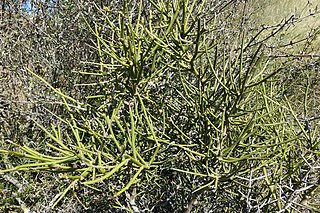
Carmichaelia petriei is a species of New Zealand broom in the genus Carmichaelia. It is endemic to New Zealand. C. petrieis is possibly a host plant for the critically endangered fungus weevil Cerius otagensis.

Dysphania pusilla, formerly Chenopodium pusillum, otherwise known as pygmy goosefoot or parahia in Māori, is a prostrate herb endemic to the north-eastern parts of South Island, New Zealand. Presumed extinct after 56 years without recorded observations, the species was rediscovered in 2015.
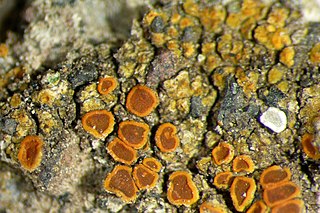
Caloplaca allanii is a species of saxicolous (rock-dwelling) and crustose lichen in the family Teloschistaceae. Found in New Zealand, it was formally described as a new species by Alexander Zahlbruckner. The type specimen was collected by Lucy Cranwell on Anawhata Beach in 1932; she sent a dried specimen to Zahlbruckner for identification. The specific epithet allanii honours New Zealand botanist Harry Allan.
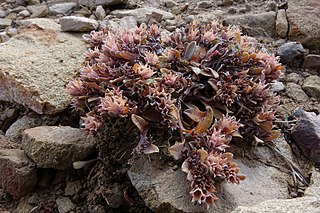
Myosotis glauca is a species of flowering plant in the family Boraginaceae, endemic to the South Island of New Zealand. George Simpson and J.S. Thomson described M. pygmaea var. glauca in 1942, and Peter de Lange and John Barkla recognized it at species rank in 2010. Plants of this species of forget-me-not are perennial with a prostrate habit, bracteate inflorescences, white corollas, and often glaucous grey leaves.

Myosotis macrantha or the Bronze Forget-Me-Not is a species of flowering plant in the family Boraginaceae, endemic to the South Island of New Zealand. Joseph Dalton Hooker described the species as Exarrhena macrantha in 1864, and Thomas Cheeseman transferred it to the genus Myosotis in 1885. Plants of this species of forget-me-not are perennial rosettes with ebracteate inflorescences and yellow to dark purple corollas with stamens that are exserted.
John E. Braggins is a New Zealand botanist and bryologist, known for his research into ferns and liverworts. Braggins lectured at the University of Auckland from 1969 until 2000, during which time he supervised and mentored a significant number of New Zealand botanists. During Braggins' career, he has taken part in the identification of 12 species and one suborder, many of which are endemic New Zealand liverworts.

Libertia cranwelliae is a species of flowering plant in the family Iridaceae. The plant was first described by Dan Blanchon, Brian Grant Murray and John E. Braggins in 2002, and is native to New Zealand.

Libertia mooreae is a species of flowering plant in the family Iridaceae. The plant was first described by Dan Blanchon, Brian Grant Murray and John E. Braggins in 2002, and is native to New Zealand.

Kunzea sinclairii, also known as the Great Barrier Island kānuka, is a flowering plant in the myrtle family, Myrtaceae and is endemic to Great Barrier Island in the Auckland Region, New Zealand.

Lepidium amissum, also known as Waitakere scurvy grass, is an extinct species of plant in the family Brassicaceae. The plant was first described by Peter de Lange and Peter Brian Heenan in 2013, and was formerly endemic to the sea cliffs of the Waitākere Ranges of West Auckland, New Zealand.

Olearia allomii, also known as the Great Barrier tree daisy, is a species of flowering plant in the family Asteraceae. The plant was first described by Thomas Kirk in 1871, and is endemic to Great Barrier Island and nearby Hauraki Gulf islands in the Auckland Region, New Zealand.

Senecio pokohinuensis, also known as the Mokohinau groundsel, is a species of flowering plant in the family Asteraceae. The plant was first described as a subspecies of Senecio repangae in 1998, and elevated to species status in 2022. It is endemic to the Mokohinau Islands of the Auckland Region, New Zealand.

The Auckland Region of New Zealand is home to numerous endemic flora and fauna. Many of these species have ranges restricted to the Waitākere Ranges, Great Barrier Island, Little Barrier Island and the Mokohinau Islands. A number of species have restricted ranges that include areas outside of the Auckland Region, such as Buller's shearwater and Pycroft's petrel, or organisms such as the brown teal / pateke and stitchbird / hihi which have recently increased ranges due to conservation efforts.
























